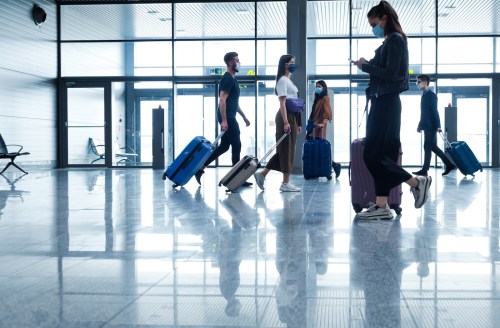What COVID-19 Spikes Reveal About Health-Care Inequity Around the World
A writer discusses her experience and understanding of COVID-19 health-care disparities around the world.

I’m writing this from the doctor’s office waiting room in Sydney, Australia. I do not require critical care—I’m here for a general checkup. I’m accessing this service with no out-of-pocket cost. It’s all covered.
I was born and raised in Australia and moved to Los Angeles in 2018. After being unable to return to Sydney for over two years, I finally visited home in December. I brought more than Christmas presents and hugs with me—I brought gratitude for easily accessible medical treatment.
It’s not lost on me that healthcare access varies widely across the globe, and the pandemic has made this clearer than ever before. In 2020, COVID-19 cases rose worldwide, but Australia managed to keep them at bay for the most part. In the first few months of the pandemic, I’d speak to my mom, and she’d tell me about the new six cases, while I’d tell her about the 60,000.
There were lockdowns and restrictions in the U.S., but in Australia, six cases often meant a harsh stage-four lockdown. While there were a handful of anti-lockdown protests around the country, it was nothing like the demonstrations in the U.S. The largest demonstration in Sydney was in July 2021, when 3,500 came out to show their dissatisfaction with strict lockdown legislation. But this was nothing like the ongoing ones Stateside. One of the first protests in the U.S. happened in April 2020. The protest, named Operation Gridlock, saw 20,000 people show up. Australia and the US felt like two vastly different realities—but that sentiment extends far beyond these two countries.
There are so many differences in accessing basic health care and COVID-19 vaccines. However, what happens in one country has ripple effects around the globe. This interconnectedness made me wonder about how other countries were experiencing, not just COVID-19 cases but global vaccination rates and challenges.
Last year, The World Health Organization (WHO) targeted achieving total vaccination rates of 40 percent in every country by the end of 2021. And while WHO aims to have 70 percent of all countries vaccinated by June 2022, WHO’s director-general, Tedros Adhanom Ghevreyesus, shared in a recent keynote speech that they are “still far off track” from achieving their goal.
“It is only possible to reach the global vaccination target of 70 percent if the world leaders step up and do their part in addressing the severe inequalities and funding gaps,” says Kim Thelwell, vice president of policy and communications at Borgen Project, a nonpartisan and nonprofit organization that advocates for global poverty reduction legislation, as well as international funds for COVID-19.
As of April 18, 2022, 15 percent of people in low-income countries have received at least one vaccine dose, reports Our World in Data. “Becoming vaccinated has been out of reach for billions of people around the world,” says Thelwell. With limited access and supplies, low-income nations have relied on COVAX, the WHO-partnered distribution scheme that aims to guarantee fair and equitable access to the COVID-19 vaccine for every country worldwide. One of the significant barriers has been vaccine hoarding. “There’s a number of factors including vaccine hoarding by wealthy nations, who have secured enough doses to vaccinate their populations several times over,” shares Thelwell.
But it’s not just vaccine availability and accessibility. In March 2021, a report by CARE indicated that policymakers need to invest at least $5 in the rollout for every $1 they spend on vaccines. This includes allocating funds to health workers and their safety, infrastructure planning, and vaccine awareness campaigns. And despite an unequal global vaccine distribution, other factors, such as the virus’ mutations, come into place. Adhanom Ghevreyesus recently clarified that we’re not close to being out of the woods, even three years in.
“Although several countries have lifted restrictions, the pandemic is far from over—and it will not be over anywhere until it’s over everywhere,” he said on March 17, 2022, adding, “I know we are all ready to move on, but it is far too early to declare victory over COVID-19.”
I reiterate what Ghevreyesus shares: The COVID-19 pandemic will not be over anywhere until it’s over everywhere. As we watch the news and read articles, it can seem like we’re living in different realities, but what I’ve learned is that what happens in one corner of the world impacts us all at the end of the day. It’s a global pandemic.
Oh hi! You look like someone who loves free workouts, discounts for cutting-edge wellness brands, and exclusive Well+Good content. Sign up for Well+, our online community of wellness insiders, and unlock your rewards instantly.
Sign Up for Our Daily Newsletter
Get all the latest in wellness, trends, food, fitness, beauty, and more delivered right to your inbox.
Got it, you've been added to our email list.










